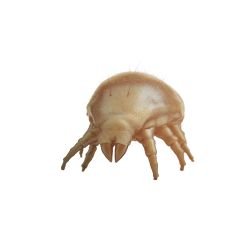House dust mites

Identification
The color of house dust mites is white.
House dust mites are so small that they cannot be seen with the naked eye, measuring only around 0.2 to 0.3 millimeters in length.
The body of a house dust mite consists of two main segments: the head and thorax fused and an elongated abdomen. The house dust mite’s body is covered by a tough, flexible exoskeleton that supports and protects its internal organs.
Get A Free Quote
We are affordable Pest Control Service in GTA & Surroundings Areas.
What are house dust mites and how do they cause problems?
House dust mites are tiny creatures that commonly live in our homes, particularly in bedding, carpets, and furniture. They thrive in warm and humid environments and feed on dead human skin cells. Although they are too small to be seen by the naked eye, their fecal pellets and body fragments can trigger allergies and asthma symptoms such as sneezing, runny nose, itchy eyes or throat, coughing, wheezing or shortness of breath.
House dust mites cause problems for many people around the world. Children who are exposed to high levels of house dust mites may develop asthma later in life. In summary, house dust mites are microscopic organisms that can cause a range of health problems for those who are sensitive or allergic to them. They thrive in warm environments with an abundance of dead skin cells to feed on.
The larvae of weevils feed on the plant material, causing damage to crops and stored food products. They also help in the decomposition process by breaking down organic matter. Weevils can affect different types of crops, such as rice, wheat, corn, beans, and peas, among others.
Habitat, Behaviour, Lifecycle
House dust mites are tiny arachnids that are found in almost every home in Canada. They are commonly found in areas with a lot of human and animal activity, such as homes, schools, and workplaces. House dust mites feed on shed human and animal skin, fungi, and spilled food, and they can live wherever they find expelled skin.
Regarding their behaviour, house dust mites are most active during the night when they come out to feed. During the day, they will remain hidden in small crevices and cracks around the home. These mites can survive in various temperatures and humidity levels, making them adaptable to different environments.
Effective ways to control dust mites and keep your home Squirrels-free with our comprehensive guide to pest management.
The life cycle of a house dust mite is relatively short, with an average life span of 65-100 days. A mated female house dust mite can last up to 70 days, laying 60-100 eggs in the last five weeks of her life. Once the eggs hatch, the larvae undergo several molts before becoming adult mites.
What are the symptoms of house dust mite infestation?
House dust mites are microscopic creatures that thrive in humid environments and feed on dead skin cells. They are a common allergen that affects millions of people worldwide, especially those with asthma or allergic rhinitis. The symptoms of house dust mite infestation may vary from person to person, but the most common ones include sneezing, runny nose, congestion, itchy eyes, and coughing.
The severity of the symptoms depends on the level of exposure to house dust mites. People who are highly sensitive to these allergens may experience more severe symptoms than others. People may also develop eczema or hives due to an allergic reaction caused by house dust mites. If left untreated, prolonged exposure to house dust mites can lead to asthma attacks and other respiratory problems.
To prevent the symptoms associated with house dust mite infestation, it is crucial to maintain good hygiene practices at home. Regular vacuuming and cleaning can reduce the amount of dust in your home and decrease the risk of developing allergies or respiratory issues caused by house dust mites. Additionally, using hypoallergenic bedding materials can help prevent an allergic reaction while you sleep.
Residential Pest Control Service
Customized pest control treatments can be used to safeguard your living space against bothersome pests and ensure that they don’t become a nuisance in your home.
How to get rid of house dust mites: Methods and tips
House dust mites are a common problem in homes, especially during the warmer months. These tiny creatures feed on dead skin cells and thrive in warm, humid environments. They often cause allergies and asthma attacks, so getting rid of them is essential for a healthy home environment. Here are some methods and tips to help you eliminate house dust mites.
- Firstly, regularly cleaning your home is crucial for keeping these pests at bay—frequently vacuum carpets, rugs, upholstery and curtains to remove dust particles that attract mites.
- Use a vacuum cleaner with a HEPA filter to ensure the dust doesn’t escape into the air. Wash bedding and linens in hot water weekly to kill off any mites hiding there.
- Another effective method is using allergen-proof covers on mattresses and pillows as it traps dust mites inside where they can’t escape or breed further.
- Additionally, limit humidity levels by using dehumidifiers or air conditioners, which make it difficult for these pests to survive since they prefer high humidity levels above 50%.
